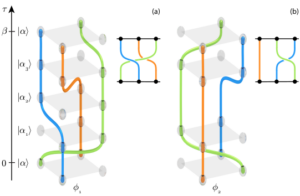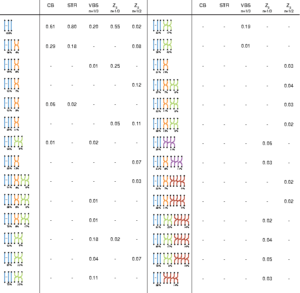Within the path-integral approach of quantum mechanics, transition probability amplitudes
can be computed in terms of superpositions of classical paths. In this formulation, all possible routes are taken into account but only those which superpose constructively will contribute the most to the quantum physical process.
Therefore, there exists a parallel between a certain quantum process and a set of classical possibilities which result in the same outcome. We use this analogy and consider quantum strongly-correlated many-body ground-states as described in terms of constructive superposition of collections of classical paths, i.e. worldline configurations (see picture below for an example of worldliness configurations of three particles on a 2X2 lattice).
Configurations emerge within the framework of Feynman’s path-integral formulation of the density matrix of a many-body system, in the limit of zero temperature. Within this framework, each quantum particle is mapped onto a trajectory (also known as worldline) in space and imaginary-time, so that the quantum system is now described in terms of collections of worldlines in space and imaginary-time, i.e. worldline configurations. As a result, there exists a correspondence between the D-dimensional quantum system and a (D+1)-dimensional classical system. Each worldline configuration is the analog of a single-particle space-time path in the path-integral formulation of quantum mechanics. The kinetic-energy term in the Hamiltonian drives worldlines to intertwine with each others. For hard-core bosons, these intertwined set of worldlines can be interpreted as braids and therefore can be assigned a topological structure, i.e. a way to classify braiding events among worldlines. Configurations can be considered as a visualization of the interplay between the kinetic and interaction terms of the Hamiltonian. The interplay between these two terms is ultimately responsible for ground-state properties. Therefore, one can expect that braiding properties of configurations should reflect ground-state properties. In the figure above, smaller figures are depictions of geometric braids associated to the worldlines configurations. In these depictions, only occupied sites are included and cut worldlines are the ones behind another worldline. Our preliminary results show that braiding properties of relevant configurations can reflect known features of the ground-state considered.
To partially characterize braids, we study the statistics of permutation cycles. Permutation cycles are obtained by gluing together worldlines at imaginary time 0 and beta. In the table below, we sketch the most probable (with a probability greater than 0.01) arrangement of permutation cycles (first column) for a variety of insulating phases, with corresponding probability to appear in the expansion of the partition function (remaining columns).
Each arrangement of permutation cycles is represented in terms of the fraction of worldlines (percentages under the braid diagrams) participating to the corresponding permutation cycle. We notice that for checkerboard (CB) and stripe (STR) phases more than 60% of the configurations are trivial braids while most of the remaining ones only possess one or few permutation cycles involving two worldlines. In the valence-bond (VBS) case, 57% of configurations possess permutation cycles involving three particles consistent with local resonances harbored in isolated hexagons occupied by three particles. Finally, permutation cycles involving four and five particles only appears in the Z2 phase with, in some cases, 30-40% of particles involved in permutation cycles with more than one particle. The observation that longer permutation cycles only appear in the Z2 phase and a considerable number of particles are involved in them is consistent with the presence of more complicated braids which extend throughout the lattice. Overall, all these observations support our expectation that the relevant topological structures would reflect certain ground-state properties.
To learn more, see:
Other relevant publications:
Permutation cycles of hardcore Bose-Hubbard models on square and kagome lattices or on arXiv

